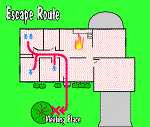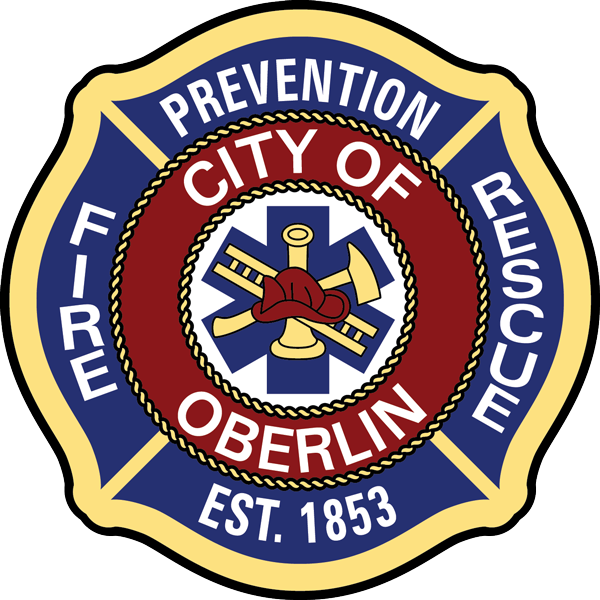Home Escape Plans
Each family member must know what to do in the event of a fire in their home. Unless a small fire can be easily controlled, it is recommended that fighting the fire be left to professional firefighters and that family members escape safely from the home.
 A home escape plan must be created and practiced so that each person knows exactly what to do. It also is important to practice Exit Drills In The Home (EDITH).
A home escape plan must be created and practiced so that each person knows exactly what to do. It also is important to practice Exit Drills In The Home (EDITH).
Most residential fires occur between 8 p.m. and 8 a.m. Deaths from residential fires occur in greater numbers between midnight and 4 a.m. when most people are asleep. An average of 800 fires strike residential buildings each day in the United States. More than 6,500 persons die each year from fire – more than half of them children and senior citizens. The majority of these deaths are in home fires.
Regardless of the cause of the fire, a home may be filled with smoke. This is a very dangerous situation. Family members may be unable to see very well. The smoke and toxic gases may cause dizziness and disorientation. In the confusion, one can easily become lost or trapped in the home. Family members must understand that their safety depends upon quickly leaving the home. It has been proven that exit drills reduce chances of panic and injury in fires and that trained and informed people have a much better chance to survive fires in their home.
Plan Ahead
The first step in escaping a fire in the home is to plan ahead. By installing smoke detectors in the home and being sure they are in good working order, family members can be alerted to the presence of smoke or fire before it is too late. Together, family members can decide on an escape plan in the event of a fire in the home.
Bedroom doors should be closed while people are sleeping. It takes fire 10 to 15 minutes to burn through a wooden door. That’s 10 to 15 minutes more for the inhabitant to escape. Next, family members should visit each bedroom and figure out two escape routes –
- The normal exit
- The other exit through a door or a window
Plan an Escape Route
Each member of the family should know how to get safely outside by at least two routes. Family members should practice opening their windows to become familiar with their operation. Jammed windows should be identified and repaired. If, during a fire, a window is jammed, it may be broken out with an object and a blanket or towel placed over the frame to cover shards of glass. However, it is much safer to open a window than it is to break the glass out.
If a family feels they need the additional security, “firesafe bars” should be installed or retrofitted. An exit should not require special tools. A key is considered a special tool. Bars installed on windows should have a single action quick release device.
Realize the Danger of Smoke
Each member of the family should understand the importance of crawling low under smoke. Smoke and heat rise so the best place to find fresher, cooler air is near the floor. When a person is caught in a building filled with smoke, they should drop on hands and knees and crawl to the nearest exit. Test all closed doors before opening them. Feel the back of the door. If it is hot, don’t open it. Turn and go to the second route of exit. If the door is not hot, open slowly but be prepared to slam it closed again if there are flames.
Practice what to do if you become trapped. Since doors hold back smoke and firefighters are adept at rescue, the chances of survival are excellent. Close doors between you and the smoke. Stuff the cracks and cover vents to keep smoke out. If there’s a phone, call in your exact location to the fire department even if they are on the scene. Wait at the window and signal with a sheet or flashlight or something visible.
Establish a Safe Meeting Place
A special meeting place should be established a safe distance from the house. It could be a mailbox, the neighbor’s driveway or a large tree in the yard. Whatever it is, it must be something that is stationary and won’t be moved (such as a car). This is where everyone meets in the event of a fire. It also prevents family members from wandering around the neighborhood looking for one another, or worse, being tempted to re-enter the burning house for one thought to be trapped inside.
Once outside at the special meeting place, a person can be sent to the neighbor’s to call 9-1-1. If anyone is missing, give that information to the Fire Department immediately and tell them where the probable location of the missing person could be. Under no circumstances should anyone re-enter the burning building.
Provide for Those Requiring Additional Help
Special provisions may be required for infants, young children, disabled or the elderly who may need additional help when escaping. These provisions should be included in the home fire escape plan and discussed with family members.
When afraid, children commonly seek sheltered places such as a closet or under the bed. Encourage them to exit outside. Do not allow them to hide. Make sure children can operate the windows, descend a ladder, or lower themselves to the ground through a window. (Slide out on the stomach, feet first. Hang on with both hands. Bend the knees when landing.) Lower children to the ground before you exit from the window. They may panic and not follow if an adult goes first.
Have children practice saying the fire department number, the family name, and street address into the phone.
Practice Your Fire Escape Plan
One very good step in the planning of a home fire escape plan is to make a floor diagram of the house. Mark the regular and emergency escape routes, as well as windows, doors, stairs, halls.
A good way to practice the effectiveness of a home fire escape plan is to position each family member in his or her bed, turn all the lights off, and activate the smoke detector by depressing the test switch. Each family member should help “awaken” the others by yelling the alert. Family members should exit their rooms according to the plan, crawl low under smoke, practice feeling doors for heat, and meet in the designated location outside the home.
Not all “homes” are single residential structures but include apartments and other types of buildings. Some additional discussion may be helpful in the home escape plan.
Most high-rise or multi-story apartment complexes post fire escape plans for all residents to see and follow. However, these plans seldom include escape routes for each apartment. Family members must develop and practice an evacuation plan for their individual apartment.
Exit Safely From a Structure
Jumping from upper floors of a building should be avoided. However, it is possible to hang from a second story window and drop feet first to the ground without significant injury. A sprained ankle or broken leg is better than dying. Parents can purchase fire ladders for the bedrooms, or instruct children to use an adjacent porch or garage roof to await rescue by the fire department.
When exiting such a structure, do not use the elevator. Elevators are notorious for stopping at the fire floor and killing the people inside. A power failure may cause them to stop in between floors. Use the fire escape or an enclosed fire resistive stairwell to exit.
As a family, explore the building so that every exit, is familiar, including those from storage, laundry and recreation rooms. If the hallways become smoke-filled as the result of a fire, memory can help in finding the exits.
Look for these important features in the building – enclosed exit stairways, clearly-marked exits, clean hallways and lobbies, automatic sprinklers, fire alarm systems and smoke detectors.
